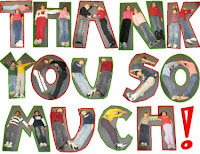Report Cards
I hope that you found your child’s report card to be helpful, in terms of informing you as to his/her progress thus far in second grade. If you have any questions or concerns, I would be happy to discuss them with you!
Thank You!
Thank you so much for ALL of your help this week! A special thank you to Mrs. Whelan and Mrs. Kasper for helping to organize the science volunteers/donations. Thanks to all of your help, students were able to participate in hands-on activities to better understand how and where fossils are formed and how careful paleontologists need to be to unearth them. Thank you!
Quick Note: Book Orders
The “deadline” for book orders is next Monday (1/30). I know that doesn't give you a TON of time, but I want to make sure that the books come in before February vacation. There are so many great books available - happy hunting!
Our Week in Review:
This week, students read the story The Alvin Ailey Kids: Dancing As a Team. This is a nonfiction story, written by Sharon Dennis Wyeth, which tells about a special dance school in
This week, students worked on creating summaries. This is a difficult skill – even for adults! We have found that it is best to go slow and (depending on the length of the selection) state the main idea of every paragraph, page, or chapter. Sometimes, we can use the exact words/sentence from the story. Other times, however, we need to use our own words to make sure that we include all the important information. Once we have identified the main ideas, then we put it all together (in order)…and PRESTO - we have a summary! It is a lengthy, and challenging, process – one that every student could use some practice with.
Suggestion: Ask your student to try and summarize a chapter or a few pages from a story that you read together. Help if/when necessary!
In spelling this week, we have been working with 6 different digraphs, including:
| sh | ch | wh | th | tch | ph |
| shut | chat | why | think | match | phone |
| push | check | where | path | scratch | graph |
| fishing | teacher | which | teeth | watching | elephant |
GRAMMAR
This week, we talked about how some verbs clearly show action and some don’t! HAVE is one of those verbs that does not show action – but it’s still a verb! Students have been working all week with this verb – learning about all the different variations and tenses (have, has, had) and when to use them.
HAVE
WRITING
We are finally finished up with our How-Tos. Feel free to come by and check them out - they are hanging in the hallway for all to enjoy!MATH
Well, so long geometry….and hello number stories! We wrapped up and assessed our geometry unit last week, and moved right into Unit 6: Whole Number Operations and Number Stories. We began this unit by working a lot with a very important concept of “finding the EASY 10.” Throughout their academic careers, it will be very beneficial for students to automatically recognize when two numbers equal 10. (e.g. 6+4; 7+3; 8+2) Identifying the “easy 10s” will help children solve problems quickly and efficiently. Encourage your child to be on the look-out for easy tens. They are everywhere! J
Later in the week, we talked a lot about comparison number stories and Comparison Diagrams. Here are a few things to keep in mind when working with your child at home:
Math Vocabulary/Definitions
Quantity is another word for amount.
Difference means subtraction (in most math number stories)
Comparison Diagrams
Helpful hints:
The comparison diagram has an uncanny resemblance to our friendly math fact triangle.
On Thursday, students participated in an activity in which they pretended to be paleontologists. Working in teams of 4-5, students listened to a little story/script and gradually “discovered” fossils of an unknown animal. They worked with their fellow colleagues to try and piece together the bones and determine what kind of animal it could be. They conferred with other teams and eventually consulted a reference manual. It was interesting to see what their final conclusions were! Here are the students at work:
Students also had the opportunity to experience how paleontologists look for and dig out fossils!! On Friday, with the help of several fabulous parent bakers, students participated in a “Cookie Excavation!” Each student excavated two cookies, recording and classifying the “fossils” found within each cookie. Check out the pictures:
































































